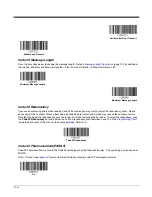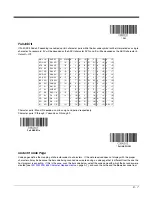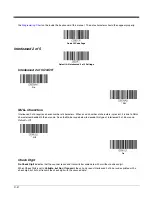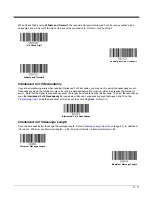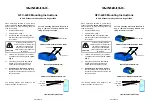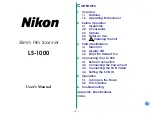
8 - 8
The data is output as:
DEFGHIJ
<CR>
Search backward for a character
F9 Search the input message backward for “xx” character from the current cursor position, leaving the cursor pointing to
the “xx” character.
Syntax = F9xx
where xx stands for the search character’s hex value for its ASCII code.
Refer to the
ASCII Conversion Chart (Code Page 1252),
beginning on page A-3 for decimal, hex and character codes.
Search forward for a string
B0 Search forward for “s” string from the current cursor position, leaving cursor pointing to “s” string. Syntax = B0nnnnS
where nnnn is the string length (up to 9999), and S consists of the ASCII hex value of each character in the match string.
For example, B0000454657374 will search forward for the first occurrence of the 4 character string “Test.”
Refer to the
ASCII Conversion Chart (Code Page 1252),
beginning on page A-3 for decimal, hex and character codes.
B0 Example: Send bar code data that starts after a string of characters
Search for the letters “FGH” in bar codes and send all the data that follows, including “FGH.” Using the bar code
above:
Command string:
B00003464748F10D
B0 is the “Search forward for a string” command
0003 is the string length (3 characters)
46 is the hex value for “F”
47 is the hex value for “G”
48 is the hex value for “H”
F1 is the “Send all characters” command
0D is the hex value for a CR
The data is output as:
FGHIJ
<CR>
Search backward for a string
B1 Search backward for “s” string from the current cursor position, leaving cursor pointing to “s” string. Syntax = B1nnnnS
where nnnn is the string length (up to 9999), and S consists of the ASCII hex value of each character in the match string.
For example, B1000454657374 will search backward for the first occurrence of the 4 character string “Test.”
Refer to the
ASCII Conversion Chart (Code Page 1252),
beginning on page A-3 for decimal, hex and character codes.
Search forward for a non-matching character
E6 Search the input message forward for the first non-“xx” character from the current cursor position, leaving the cursor
pointing to the non-“xx” character.
Syntax = E6xx
where xx stands for the search character’s hex value for its ASCII
code.
Refer to the
ASCII Conversion Chart (Code Page 1252),
beginning on page A-3 for decimal, hex and character codes.
E6 Example: Remove zeros at the beginning of bar code data
This example shows a bar code that has been zero filled. You may want to ignore the zeros and send all the data that
follows. E6 searches forward for the first character that is not zero, then sends all the data after, followed by a carriage
return. Using the bar code above:
Command string:
E630F10D
E6 is the “Search forward for a non-matching character” command
30 is the hex value for 0
Summary of Contents for Stratos 2700
Page 1: ...Stratos 2700 Bioptic Scanner Scale User s Guide ...
Page 6: ......
Page 20: ...1 6 ...
Page 36: ...2 16 ...
Page 96: ...5 4 ...
Page 110: ...6 14 ...
Page 130: ...8 14 ...
Page 203: ...9 73 Maximum Message Length ...
Page 204: ...9 74 ...
Page 212: ...11 2 Denmark 8 9 6 Norway 8 9 6 Spain 6 Country Codes ...
Page 214: ...11 4 ...
Page 218: ...12 4 ...
Page 244: ...13 26 ...
Page 250: ...14 6 ...
Page 256: ...15 6 ...
Page 270: ...B 2 ...
Page 273: ...Programming Chart 0 1 2 3 4 5 6 7 8 ...
Page 274: ...9 A B C D E F Save Discard ...
Page 276: ......
Page 277: ......



























